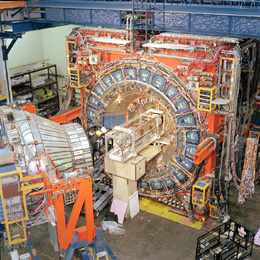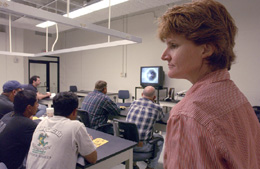 |
|
Safety First Fermilab employees set records as accident rate drops by Kurt Riesselmann
It was a tight space. The technician, 29 years old, knelt down to reach for equipment at the Collider Detector at Fermilab. To see better, he turned around to grab his flashlight. Ouch. What seemed like a routine job ended in a twisted knee and a trip to the doctor’s office. The injury was so severe that he needed surgery. The accident happened more than a year ago, on April 17,2002. It is a reminder of the dangers that can lurk in even the most routine jobs. Yet that accident also cleared the way for an amazing record. Since the accident,more than 600 employees of the Particle Physics Division have suffered no serious injuries. Working one million hours —and counting — the division set a lab-wide record for the most staff-hours without an injury serious enough to force someone to miss work or change from a normal assignment. “For more than a year, we have had no injuries resulting in lost or restricted work,”said Martha Heflin,senior safety officer for PPD.“Since the beginning of this year we haven ’t had more than a first-aid accident —cuts that required a band aid or so,but no reportable cases.” To celebrate the achievement and to re-emphasize the importance of safety in the work place,John Cooper,head of PPD,invited his division to a picnic outside Fermilab ’s Kuhn Barn on a sunny Friday,May 16.Director Mike Witherell presented the division with a safety award. “This is really a remarkable record that PPD has assembled.It sets an example for the other divisions,”Witherell said.“It is really impressive considering the work PPD does.” Many PPD work areas present industrial hazards.Lifts and cranes move heavy equipment. Maintaining and repairing large-scale equipment represent hazards by themselves.In some work areas,employees encounter the danger of confined space;in others,the possibility of oxygen deficiency,as non- poisonous gases such as helium or nitrogen may escape from their proper containers.Sometimes projects require technicians to handle hazardous materials like lead,beryllium and epoxies. And the list goes on and on.Yet it is not always the obvious dangers that cause the problems. “The big hazards everybody sees,” said Dwight Featherston, an electrical task manager at PPD who has worked at the lab for 20 years.“Most accidents are caused by something simple.” To help PPD employees recognize and handle the hazards of their work environment,the division has developed a spreadsheet that lists low-and high-level hazards. Before starting a new job, workers check the list to see whether any of the hazards apply to their job ahead. If they identify two low-or one high-level hazard,they need to write a hazard analysis and receive approval from their supervisor before proceeding with the job.
In PPD,supervisors and line managers are known for taking the time to personally inspect work areas and for talking to people about safety.If employees don ’t work safely,Cooper himself asks them to explain why. Trying to save money or time are two excuses that are unacceptable. “People can tell when it’s only talk,” said Heflin. “And that’s not John [Cooper]. For the January shutdown of the accelerator complex,thirty-six PPD techs went to help the Beams Division. John took the time to call in all these workers along with their supervisors. He reminded them that safety is the most important aspect, not schedule. He told them:‘If you feel uncomfortable doing a certain task,go tell your supervisor.’ “Ultimately, it’s because of the workers in the division that we ’ve had this success,”said Heflin. “I see the improvements when I’m out and about, when I’m in meetings with them. When they submit their plans,often they’ve already reviewed the details and identified all of the hazards.They are just looking for confirmation or a better understanding of the rules and regulations. I think that a lot of them don ’t even realize they crossed this road.” PPD’s safety achievement is the highlight of the improved safety performance of the entire lab. Both the Computing Division and the Environment, Safety and Health Section have exceeded their previous records as well,currently featuring more than 650,000 and 360,000 consecutive hours, respectively,without lost-workday cases.In the Technical Division,the Machine Shop Department, whose workers daily carry out hazardous processes —grinding,cutting,lifting,welding and similar jobs —completed 528 days without a lost or restricted workday. In April, the entire lab set a safety record as well. Over two quarters (Oct.’02 –Mar.’03),Fermilab reported only five injuries that resulted in temporary job-limiting work restrictions or in time away from work,the lowest two-quarter result ever achieved. Since the beginning of the year,the total number of lost-workday accidents per 100 workers per year has dropped to the astonishingly low number of 0.3 cases,considerably below the 2003 goal of 0.9 cases.The numbers indicate the progress the lab has made:Throughout most of the nineties Fermilab reported an average rate of 3.1 cases. The improvements are the pay-offs of a safety campaign that began in February 1998,following two serious accidents that led to safety stand- downs at the lab.Recognizing the need for change, Fermilab ’s Directorate and the Environment,Safety and Health Section introduced additional safety training. “Since February 1998, we offer DuPont training for supervisors and managers,”said Mary Logue, associate head of the ESH Section.“The DuPont company has a reputation for high safety standards and performance.At our lab,about 350 to 400 people took this two and a half day course.And we’ve seen results.People who were doubters before became believers and then leaders.” PPD employee Dervin Allen, who supervises five technicians at CDF, clearly remembers the DuPont training and how rigorously safety is promoted at the company.
“I will never forget when they talked about safety with regard to climbing stairs,” he said.“‘You always have your hand on the railing when you walk up and down the stairs.’ At DuPont,the first time you fail to do so you get yelled at. The second time you may get fired.” Better training is just one of the pro-active measures. Throughout the Fermilab site, employees have helped to identify safety hazards,from potholes in parking lots to unsafe equipment in machine shops. The following examples show the many different ways in which safety can be improved:
Many improvements aim at reducing the risk of back injuries,a high priority throughout the lab. With Fermilab’s workforce getting older,the odds of someone getting hurt while lifting an object are increasing. The fact that some equipment at the laboratory is more than thirty years old, designed when ergonomics was not a priority, sometimes makes things worse. “Back injuries have always been the largest contributor to lost work days,” said Logue. “We began offering back training courses in late 1997. The course lasts an hour and a half and is conducted by a physical therapist. To prepare the class she has gone through the lab,observing workers and their work environment. In her class she now shows photos of lab employees lifting things,and she explains how the objects could be lifted more safely.” The course has been popular;over 1,500 employees have taken it. Several divisions require all their employees to take it. The impact has been impressive.Since 1998 the average number of back injuries per year has dropped to only seven lost workday cases per year,compared to nineteen from 1995 to 1997. Despite this success, lab managers say there is no room for complacency. Every injury is one injury too many. “The bottom line is: It’s not about numbers and statistics,” Heflin says.“We want people to go home in as good a physical condition as when they arrived. We tell them:‘It’s about you. Your eyes, your hearing,your back. It’s you.’”
ON THE WEB: Fermilab’s Environment, Safety & Health Section: http://www-esh.fnal.gov Laboratory safety records by division" http://www-esh.fnal.gov/pls/default/lsc.html
|


